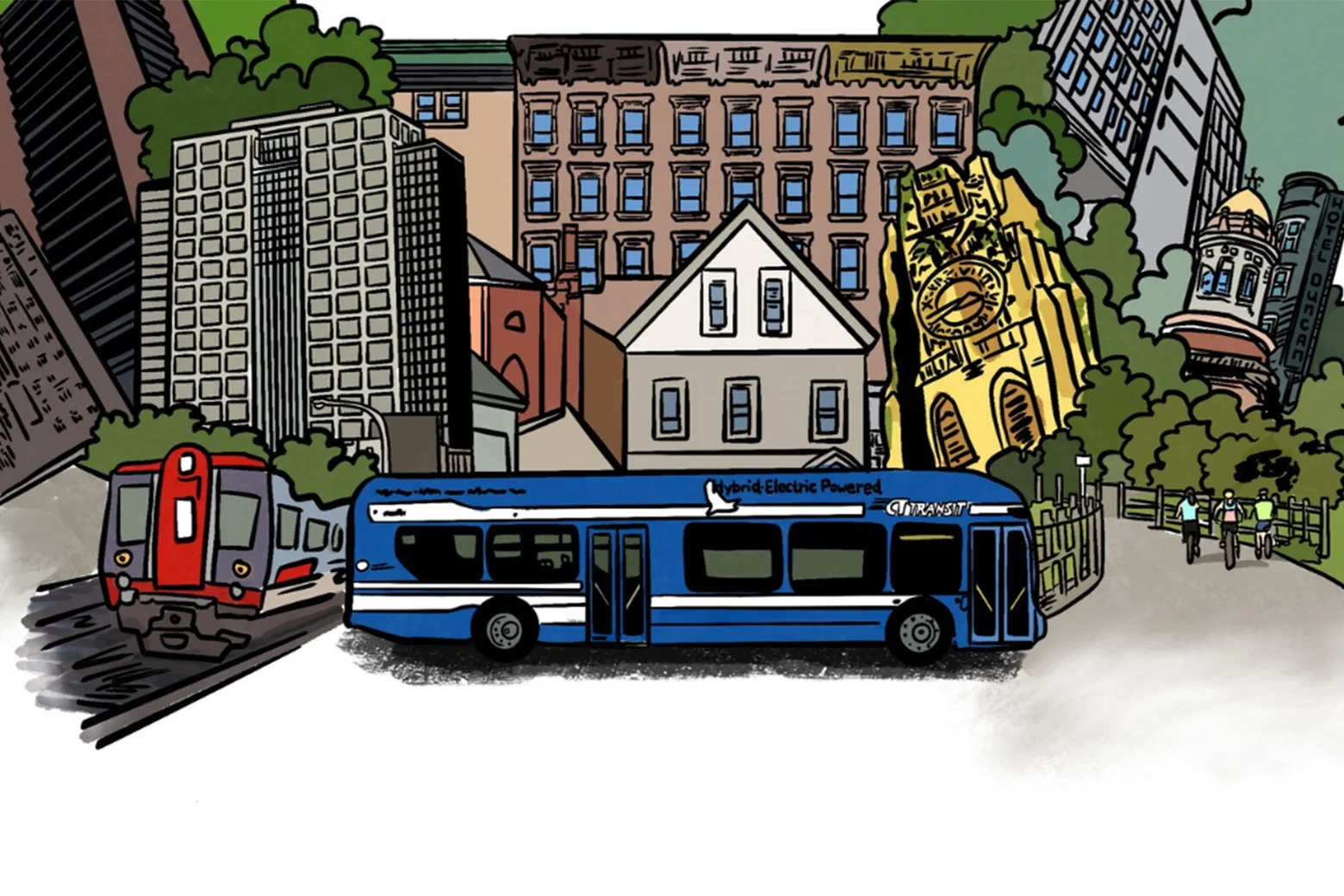
Sign up for the Slatest to get the most insightful analysis, criticism, and advice out there, delivered to your inbox daily.
Last weekend, more than a thousand people assembled in New Haven, Connecticut, for the 10th meeting of YIMBYtown. The conference—which bills itself as a “pro-homes” gathering—was first held in Boulder, Colorado, in 2016, when it was small enough that attendees could take a group photo together. No longer: Now there are governors and congresspeople in attendance, as well as big donors like Arnold Ventures and Open Philanthropy, helping to fund both the meetup and the activities of its attendees. The crowd in New Haven nearly doubled organizers’ expectations, and it was a miracle Frank Pepe’s could provide enough apizza to feed them all lunch on Monday.
This was a demonstration of how far the “yes in my back yard” cause has come since Sonja Trauss started the San Francisco Bay Area Renters Federation, or BARF, a decade ago. Beyond the stuffed hotel ballrooms, there is an unmistakable sense of momentum behind the idea—basically, “more housing, fewer rules about where it can be built”—which has been embraced by everyone from AOC to Montana Gov. Greg Gianforte. That success had in turn inspired a bestselling book that extrapolated the YIMBY victory into a broader theory of “abundance,” which purports to lead the Democratic Party out of the wilderness.
In recounting this event, I have a conflict-of-interest disclaimer longer than a table of suburban parking requirements. I was speaking about my book on one panel, as well as presenting an award in honor of the late scholar Donald Shoup. My wife, a professor of urban planning, was speaking on a separate panel. We even brought our 3-month-old son, nestled in a stroller in his “Housing Is a Human Right” onesie, the youngest person at the conference. (Who are we building this better world for, anyway?)
But I was curious to soak up the scene for other reasons. Some were personal. The conference was taking place in New Haven’s Omni Hotel, a few blocks from the Yale campus where I first encountered urban history as an undergrad two decades ago. To be back on Temple Street talking about cities was exciting, and I wanted to see how urbanists from across the country would perceive this place that had so shaped my sense of city planning.
It was an uncanny experience: Literal scores of people who had previously been disembodied online avatars or voices on the phone were now conjured before me in the flesh, like a resting-pulse sequel to Jumanji. As in any post-Zoom encounter, it was a chance to discover how tall you were, or as one attendee described the IRL meet-and-greet to me, “how autistic you are.” This was said with affection; the pro-transit movement is a natural fit for people on the spectrum.
As YIMBYtown gets upzoned, the question is, how many different types of people can you fit in a single conference before it becomes ideologically incoherent? Reducing zoning barriers has been a matter of bipartisan consensus. But just over the horizon are adjacent urban issues like homelessness, sprawl, policing, and car culture, where there is anything but agreement.
As a sign of YIMBY’s broad-based appeal, consider the choice of New Haven: a mostly poor, majority-minority, post-industrial city whose population is a double-digit percentage below its midcentury peak. A land-use reform that works both here and in San Francisco has got to be good—but also a kind of lowest common denominator in the complex politics of the city.
New Haven was a good place to study urban history: Its midcentury leaders strived to make it a “model city,” and deployed more per capita urban renewal money than in any city in the country. One of my professors, Harry Wexler, had been a young functionary under the midcentury mayor-for-life Dick Lee. Wexler told of how he and his fellow idealists in city government had sat at the feet of the urbanist Maurice Rotival, who would toss off dazzling sketches of the highways and housing projects with which they would remake the Elm City. (Rotival had cut his teeth as a colonial administrator in French Algeria, and the segue from that post to urban renewal planner says much about the program’s undemocratic failures.)
Returning to New Haven offered me a chance to reflect on how my sense of the important issues had changed through years of reporting. Then, I spent a lot of time thinking about urban renewal (native son Robert Moses was portrayed on a banner near campus) and the decline of the city, a story expertly told in Douglas Rae’s book City: Urbanism and its End. All those urban expressways did little for New Haven except establish its famous pizzerias as an easy pit stop for motorists leaving New York for points northeast.
The idea that, instead of government overreach and urban poverty, the national conversation would have shifted to government incapacity and urban prosperity, would have surprised me then. Maybe that’s the difference between studying the past and observing the present. But it’s also the difference between post-industrial New Haven, a poor city ringed by rich suburbs, and the so-called “superstar cities” whose conditions have driven the national conversation.
Demographically, as it turns out, no metro area better resembles the country at large than New Haven. But it’s a city that still suffers more from poverty and disinvestment than an excruciating shortage of housing. I was there at the dawn of the global financial crisis, as housing prices collapsed nationwide, so the cost of housing was not a top issue.
Given Connecticut’s pattern of poor cities and rich suburbs, it made sense that the local brand of YIMBY was represented by the conference’s local host and organizer, Desegregate Connecticut. It was one of many shades of the philosophy on display. Nick Kantor, the group’s program director, summed up this big-tent vibe in a closing message that referred to the four keynotes: “An anti-racist scholar, a Republican governor, a legendary environmentalist, and a housing economist walk into the Omni … sounds like the opening of a joke, but this was YIMBYtown 2025!”
In short, there was room for disagreement. A subsidiary of the broader New York–area Regional Plan Association, Desegregate CT has a mission that probably would not find much support among the funders of the neocon stalwart American Enterprise Institute, which had a table in the hallway. At a panel on the hot new trend in housing finance—revolving loan funds to help some apartment developments get underway—one woman asked how we could justify public subsidy to apartments for higher-income residents while lower-income people still had so much need. In April, a New York Times Magazine article by the premier YIMBY chronicler Conor Dougherty raised divisive questions about whether the movement needed to embrace sprawl, which many YIMBYs consider a policy failure they’re trying to fix. Last year, Dougherty noted the political vibe shift at YIMBYtown: “In addition to vegan lunches and name tags with preferred pronouns, the conference included—even celebrated—a group that had until recently been unwelcome: red-state Republicans.”
This has worked so far for YIMBYs because they are united around a coherent goal, even if they differ in the details. In New Haven, that meant having North Dakota’s GOP Gov. Kelly Armstrong speak, while making it clear that Connecticut’s own Democratic governor, Ned Lamont, who recently vetoed a groundbreaking land-use reform bill, was welcome only as an attendee. Reporters at the Yale Daily News even got comment from the office of the spurned Lamont, saying through a spokesman, “The Governor understands the RPA’s decision to not invite him to their conference YIMBYtown. He still appreciates their work and looks forward to future collaboration on a new bill to address our housing crisis.”
But the extent to which YIMBY bipartisanship can scale up to a bigger “abundance” idea is not clear. Describing the recent Abundance conference in Washington, where the organizing group YIMBY Action was a co-host, Matt Yglesias said that cause had the quality of a half-drawn horse—its toned YIMBY hind legs stitched to some hastily sketched ideas about science, medicine, justice, and foreign policy. You can see where things will begin to unravel: One speaker at the Abundance conference, for example, had endorsed “deportation abundance”—an idea morally repugnant to the housers in New Haven. “If cosmopolitanism is at the heart of YIMBY thought, then it can’t possibly occupy the same movement as a faction that wants to violently purge U.S. cities and is currently cheering on the military occupation of Washington, D.C,” wrote the former California YIMBY policy director Ned Resnikoff.
Improv veterans would say that there is a kind of collaborative fervor generated by not saying no to new ideas: the spirit of “yes, and—.” So far that has been the ethos of YIMBY, taking all comers into their city of ideas. But there are some political visions to which even the YIMBYs will say: not in my neighborhood.



